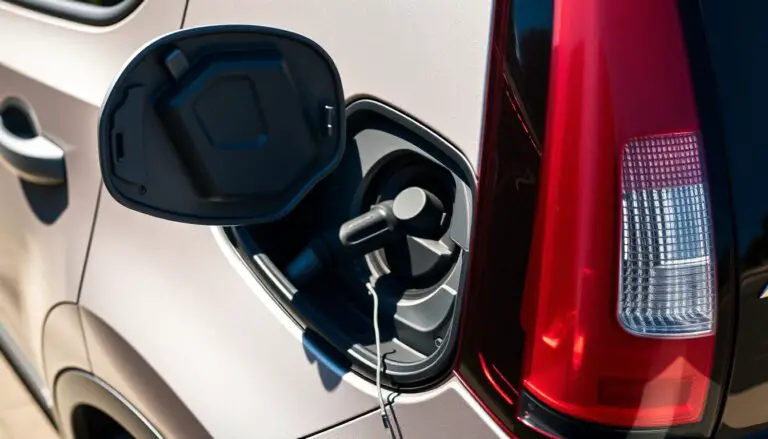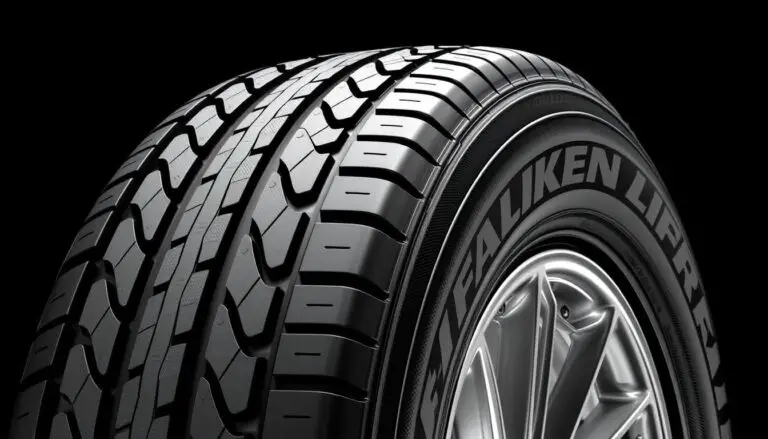For vehicle owners intent on managing their maintenance expenses, grasping the tire patching cost is paramount. The repair of a punctured tire can incur substantial costs, necessitating an understanding of the variables that dictate this expense. Such knowledge empowers car owners to make decisions that align with their financial capabilities.
A recent exchange on a car forum shed light on the disparate costs associated with tire repair. The range spans from $1.50 for a plug in 1966 to $144 per hour for labor at a different location. These extremes highlight the critical need for comprehension of the cost of tire patching.
This discourse will dissect the determinants of tire repair cost and juxtapose professional tire patching services against DIY alternatives. The aim is to equip vehicle owners with a thorough grasp of the financial implications involved, facilitating more informed decision-making.
Key Takeaways
- The average cost of tire patching includes both materials and labor.
- Labor rates can significantly impact the total tire repair cost.
- DIY solutions can be cost-effective but may not always be reliable.
- Understanding the factors that influence tire patching cost can help vehicle owners make informed decisions.
- Comparing prices and services can lead to significant savings.
Understanding Tire Patching: What It Is and When You Need It
Tire punctures are an unavoidable occurrence, yet discerning the suitability of a tire for patching is paramount for vehicular safety. The technique of tire patching serves as a repair strategy for punctures, yet its applicability is limited to specific types of tire damage.
Common Causes of Tire Punctures
Tire punctures stem from a multitude of factors, including road debris, suboptimal tire inflation, and adverse driving conditions. Grasping these causes is essential for preemptive measures against future punctures.
- Road debris such as nails, glass, and sharp rocks
- Underinflated tires that are more susceptible to punctures
- Driving over potholes or curbs
By recognizing these common causes, drivers can proactively reduce the likelihood of tire punctures.
Difference Between Patching and Plugging
Though often conflated, tire patching and plugging represent distinct repair methodologies. Tire patching entails the application of a patch to the tire’s inner liner, offering a more enduring solution. In contrast, tire plugging involves the insertion of a plug from the exterior, providing a temporary repair.
| Repair Method | Description | Permanence |
|---|---|---|
| Tire Patching | Applies a patch to the inner liner | Permanent |
| Tire Plugging | Inserts a plug from the outside | Temporary |
When Patching Is and Isn’t Appropriate
Patching is suitable for punctures situated within the tire’s tread area and of moderate size. It is, conversely, inadvisable for punctures located on the sidewall or those perilously close to the tire’s edge.

Comprehending the appropriateness of tire patching is vital for ensuring both the safety and longevity of the tire. By discerning when to employ patching and when to opt for replacement, drivers can make informed decisions regarding their vehicle’s upkeep.
How Much Does It Cost To Get A Tire Patched?
The cost of tire patching is not uniform, influenced by several variables. These include the tire’s type, the extent of damage, and the service provider’s rates.
Average Cost Range: $10-$40 Per Tire
The average cost for tire patching typically ranges from $10 to $40 per tire. This estimate pertains to standard passenger vehicles and common types of tire damage. For instance:
- Simple punctures in the tire’s tread area might be on the lower end of the spectrum, around $10-$20.
- More complex repairs or those requiring additional services (like tire balancing) could cost between $20-$40.
It is crucial to acknowledge that these figures are estimates. Actual costs may fluctuate based on the service provider and location.

Regional Price Variations Across the United States
Tire patching costs exhibit significant regional disparities across the United States. Urban areas, characterized by higher labor costs and service demand, tend to have elevated prices. For example:
- Major cities like New York or Los Angeles might see prices on the higher end of the spectrum or even exceeding $40 due to high labor costs.
- Rural areas or smaller towns might offer more competitive pricing, potentially lower than the average range.
Case Study: Price Comparison Across 5 Major Tire Service Chains
To provide a clearer perspective, let’s examine the prices of tire patching services across 5 major tire service chains in the United States:
| Tire Service Chain | Average Price | Additional Services |
|---|---|---|
| Discount Tire | $15-$30 | Tire balancing, rotation |
| Costco Tire Centers | $12-$25 | Included with tire purchase |
| Sam’s Club Tire Centers | $13-$28 | Free with membership |
| Tire Barn Warehouse | $18-$35 | Wheel alignment services |
| Les Schwab Tire Centers | $15-$32 | Free tire inspection |
This comparison underscores the variability in pricing and services offered by different chains. It highlights the necessity of exploring multiple options to secure the most favorable value.
Factors That Influence Tire Patching Costs
Understanding the elements that affect tire patching costs is crucial for making informed decisions. The cost of tire patching is not a fixed rate and can vary based on several critical factors.
Tire Type and Size Impact on Pricing
The type and size of the tire play a significant role in determining the cost of patching. Larger tires, such as those used on trucks or SUVs, typically cost more to patch than standard car tires. Specialized tires, like those for racing or off-road vehicles, may require more expensive patching procedures due to their unique construction or materials.
A study by Tire Review found that the average cost to patch a standard passenger vehicle tire ranges from $10 to $20, while larger tires can cost between $20 to $40 to repair. The size and type of tire are crucial factors in determining the cost.
| Tire Type | Average Patching Cost |
|---|---|
| Standard Passenger Vehicle | $10-$20 |
| Truck or SUV | $20-$40 |
| Specialized (Racing/Off-road) | $30-$60 |
Damage Severity and Location on the Tire
The severity and location of the damage on the tire are also critical factors that influence the cost of patching. Punctures in the tire’s sidewall or near the shoulder can be more challenging to repair and may require more extensive (and costly) procedures. As Consumer Reports notes, “Repairs on the sidewall are generally not recommended and may not be possible.”
A puncture in a more accessible location, such as the center of the tread, is typically easier and less expensive to repair. The complexity of the repair directly impacts the cost.
Service Provider Type: Dealerships vs. Independent Shops
The choice between a dealership and an independent repair shop can also affect the cost of tire patching. Dealerships often charge more for their services due to higher labor rates and the use of original equipment manufacturer (OEM) parts. In contrast, independent shops may offer more competitive pricing.
“Independent tire shops can offer significant savings compared to dealerships, often at a comparable level of quality.”
- Dealerships: Higher labor rates, OEM parts
- Independent Shops: Competitive pricing, potentially lower labor rates
Additional Services Often Bundled with Patching
Additional services such as tire balancing, rotation, or inspection are often bundled with patching. While these services add to the overall cost, they can provide long-term benefits by ensuring the tire operates smoothly and safely. The total cost for these bundled services can range from $20 to $100, depending on the services included.
For example, a tire balancing service might cost an additional $10 to $20. As Edmunds suggests, “Regular tire maintenance, including balancing and rotation, can extend the life of your tires.”
Professional Tire Patching vs. DIY Solutions
The choice between professional tire patching and DIY solutions hinges on various factors, including cost and safety. Professional services bring expertise and warranty, whereas DIY kits offer an immediate, cost-effective remedy for minor punctures.
Cost Breakdown of DIY Tire Patch Kits
DIY tire patch kits are readily available, priced between $5 and $20, contingent upon the kit’s quality and scope. These kits encompass patches, adhesives, and tools essential for the repair. For example, a basic kit from John Deere might include a tire patch kit with detailed instructions, whereas more advanced kits from Slime may include additional sealants for puncture repair.
Tools and Skills Required for Self-Repair
To effectively repair a tire with a DIY kit, one must possess basic tools such as tire levers, a spare tube (if necessary), and a pump or compressor. Mechanical aptitude and a grasp of tire repair fundamentals are also imperative. The process entails removing the tire, pinpointing the puncture, cleaning the area, and applying the patch. It’s essential to adhere to the manufacturer’s instructions to guarantee a proper seal.
Long-term Cost Considerations and Tire Longevity
Though DIY repairs may be economical in the short term, their long-term durability is variable. A meticulously executed DIY patch can prolong a tire’s life, but a subpar repair might precipitate further damage or even a blowout. Professional repairs, with their accompanying warranty, are generally more durable. It is vital to weigh the long-term cost implications and the likelihood of future repairs when deliberating between DIY and professional services.
Safety Implications of DIY vs. Professional Repairs
Safety is paramount in tire repairs. DIY repairs, if executed incorrectly, can result in tire failure, notably at elevated speeds. Professional tire patching services, conducted by trained technicians, offer a safer alternative. They possess the requisite equipment and expertise to ensure the repair meets safety standards. In cases of uncertainty, opting for professional tire patching is the safer option.
When Patching Isn’t Enough: Replacement Costs Comparison
Tire patching, a cost-effective solution for minor punctures, may not always be the optimal choice. Certain scenarios necessitate tire replacement, offering both safety and economic advantages in the long term. It is imperative for drivers to comprehend these scenarios to make informed decisions regarding their vehicle’s maintenance.
Scenarios Where Replacement Is Necessary
Several conditions dictate the necessity for tire replacement. Severe damage that impairs the tire’s structural integrity is a clear indicator that patching is insufficient. This encompasses large punctures, sidewall damage, and tires driven on while flat for an extended duration. Tires worn beyond the minimum tread depth or exhibiting uneven wear patterns also necessitate replacement.
The age of a tire is another critical factor. Even if a tire appears to be in good condition, its age can be a determining factor for replacement. Most tire manufacturers advocate for tire replacement after six years, regardless of tread depth. The degradation of the rubber compound over time impacts the tire’s performance and safety.
Average New Tire Costs by Vehicle Type
The cost of a new tire varies significantly based on vehicle type, tire size, and brand. On average, a new tire for a passenger vehicle can range from $100 to $300. SUVs and light trucks typically see costs between $150 to $400 per tire. High-performance or specialty tires can exceed $500 per tire.
- Passenger vehicles: $100-$300
- SUVs and light trucks: $150-$400
- High-performance vehicles: $200-$500+
Cost-Benefit Analysis: Multiple Patches vs. New Tire
When considering patching versus new tire replacement, several factors are at play. Patching can serve as a temporary fix but repeated repairs can escalate costs. Each patch can potentially compromise the tire’s integrity, impacting performance and safety.
A cost-benefit analysis often reveals that tire replacement is more economical and safer than multiple patches. For instance, if a tire requires a second patch, the cumulative cost can approach or exceed the price of a new tire. The risk associated with a potentially failing patched tire can lead to additional expenses, such as wheel damage or, worse, an accident.
In conclusion, while tire patching is a viable solution for minor damages, understanding when to opt for a replacement is crucial for both safety and economic considerations. By considering the scenarios where replacement is necessary, the average costs of new tires, and conducting a cost-benefit analysis, drivers can make informed decisions that balance immediate costs with long-term safety and financial implications.
Conclusion
Tire patching emerges as a financially prudent strategy for upholding vehicular safety and roadworthiness. The expense for such a procedure can fluctuate between $20 and $60 per tire, influenced by variables such as tire type, extent of damage, and the service provider’s expertise.
A comprehensive analysis of tire patching expenditures underscores the criticality of comprehending regulatory frameworks governing tire repairs. This knowledge is paramount to guarantee the continued safety and roadworthiness of the vehicle. By meticulously evaluating these elements, vehicle proprietors can make well-informed decisions regarding tire repair and upkeep.
In contemplating the final aspects of tire repair, it is imperative to juxtapose the costs and advantages of patching against replacement. Patching serves as a provisional remedy, whereas replacement becomes imperative for severe damage or excessive wear. Through a nuanced understanding of these dynamics, vehicle owners can effectively manage their tire maintenance expenditures, thus ensuring their vehicle’s safety on the thoroughfares.
FAQ
What is the average cost of tire patching?
The average cost for tire patching spans from to per tire, influenced by tire type, size, and the service provider’s rates.
How does tire type and size impact patching costs?
Larger and specialty tires, such as those for trucks or performance vehicles, incur higher patching costs compared to standard passenger vehicle tires.
Can I patch my tire myself, and is it cost-effective?
DIY tire patch kits are priced between -, yet professional patching is advisable for safety and long-term cost-effectiveness.
When is it necessary to replace a tire instead of patching it?
Replacement is imperative for severe damage, such as sidewall punctures, or when the tire’s tread depth is below the recommended level.
How do regional prices across the United States affect tire patching costs?
Prices fluctuate by region due to labor costs, service provider rates, and local market conditions.
What additional services are often bundled with tire patching?
Services like tire balancing, rotation, and inspection are commonly bundled with patching, increasing the overall cost.
Are there any safety implications to consider when choosing between DIY and professional tire repairs?
Yes, professional repairs are generally safer, as they are executed by trained technicians with proper equipment and adherence to industry standards.
How do dealerships and independent shops compare in terms of tire patching costs?
Dealerships typically charge more than independent shops, though prices can differ based on the specific service provider and location.
What are the long-term cost considerations for tire patching versus replacement?
While repeated patching may appear cost-effective in the short term, it may not be the optimal long-term strategy, potentially leading to decreased tire performance and safety.


